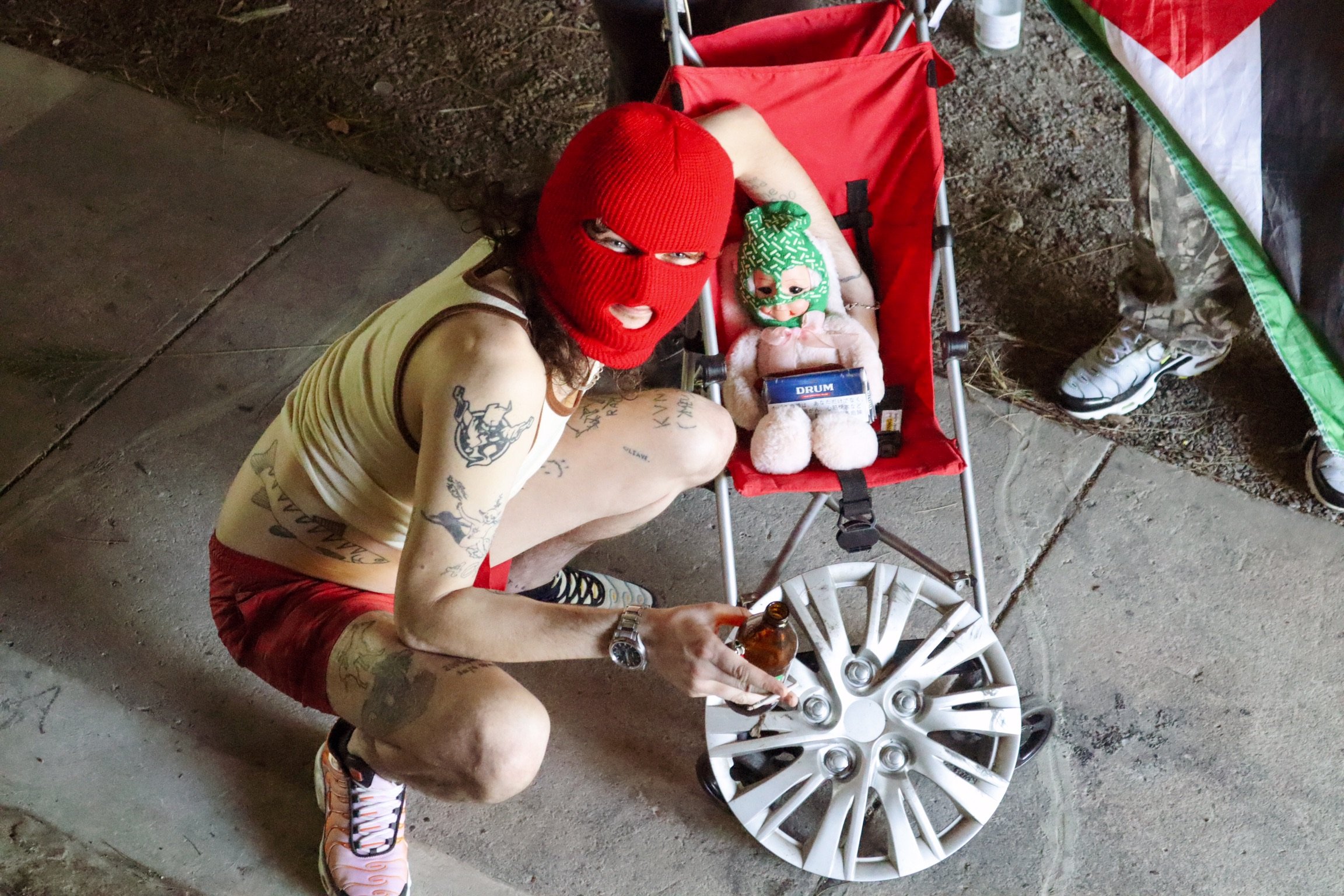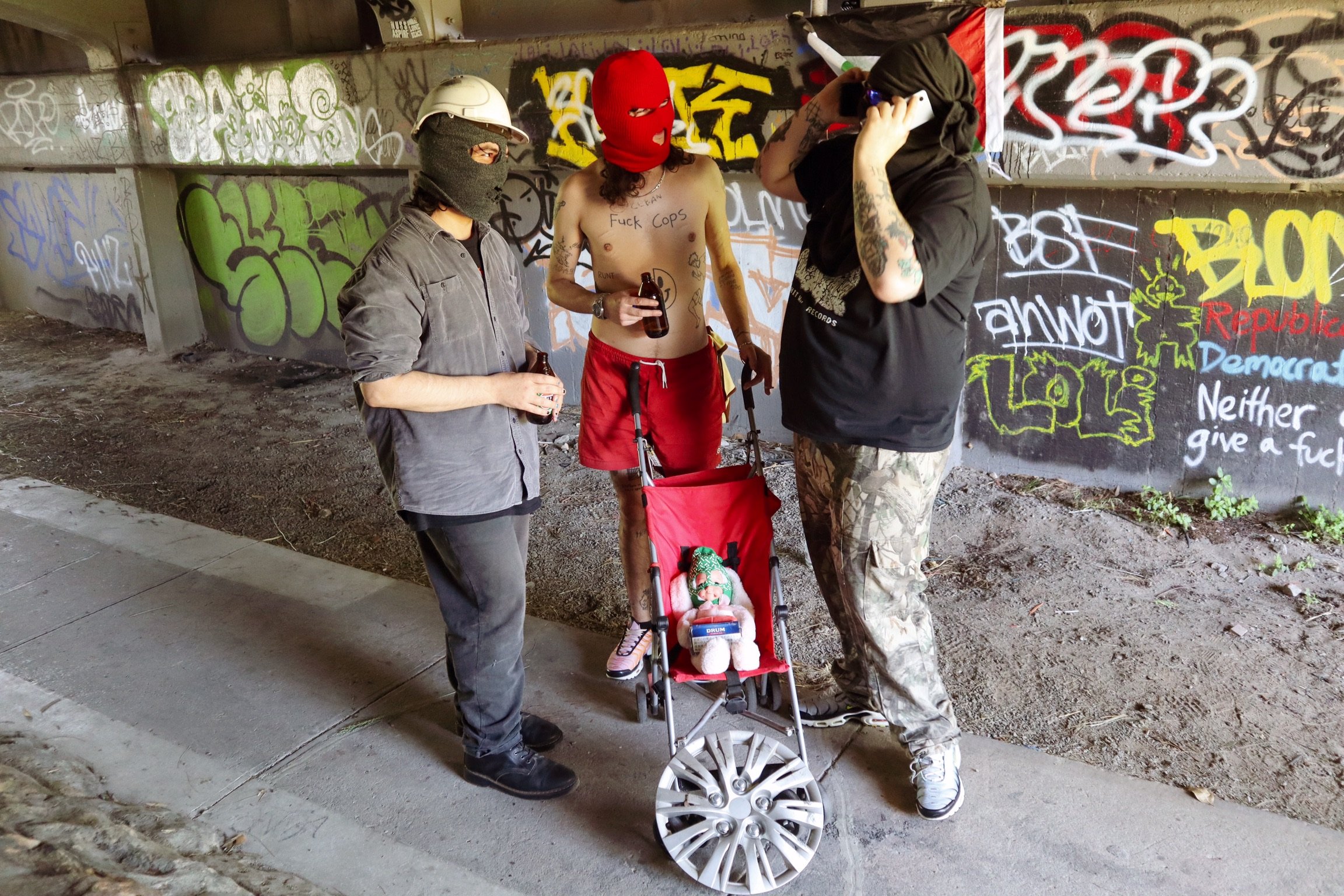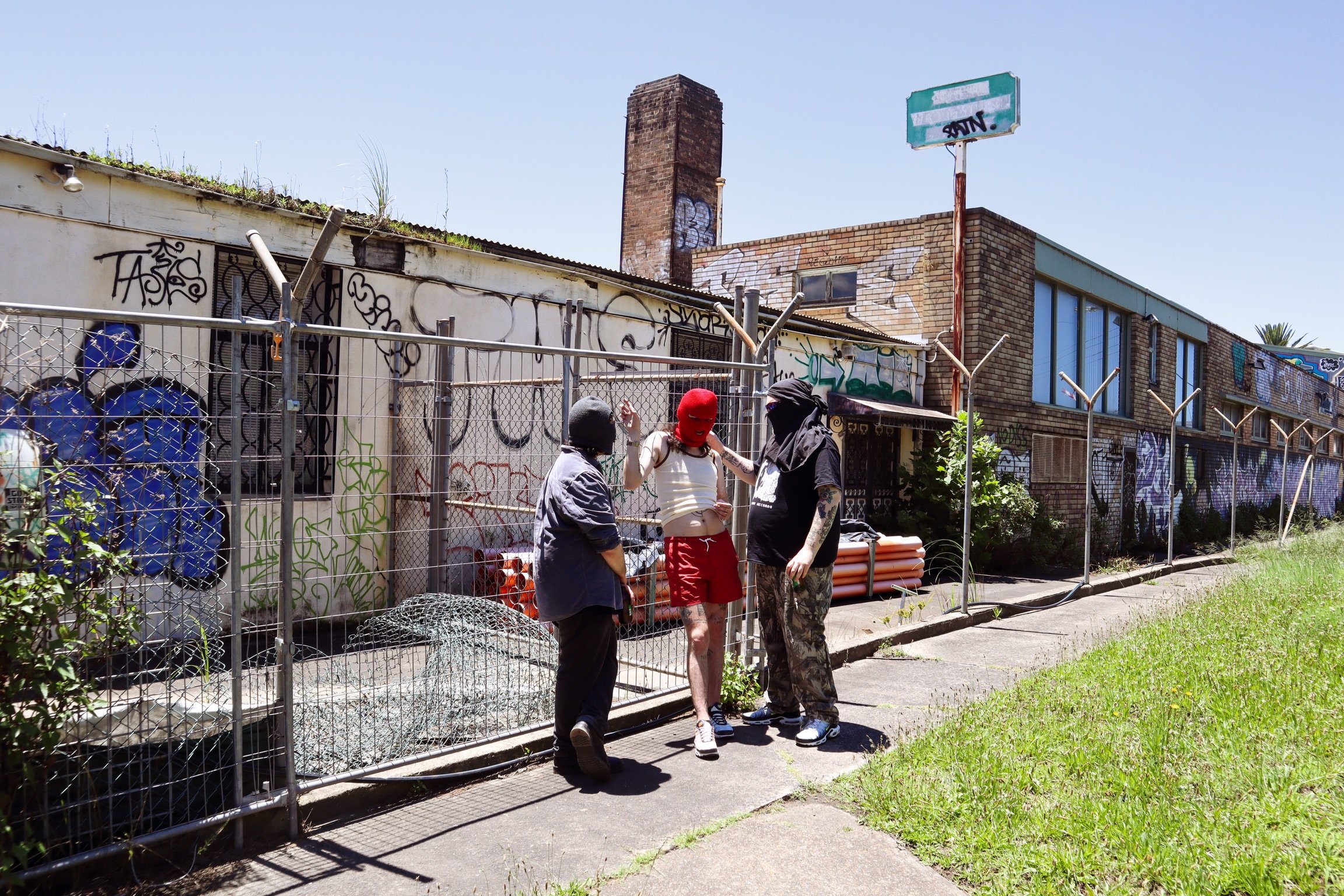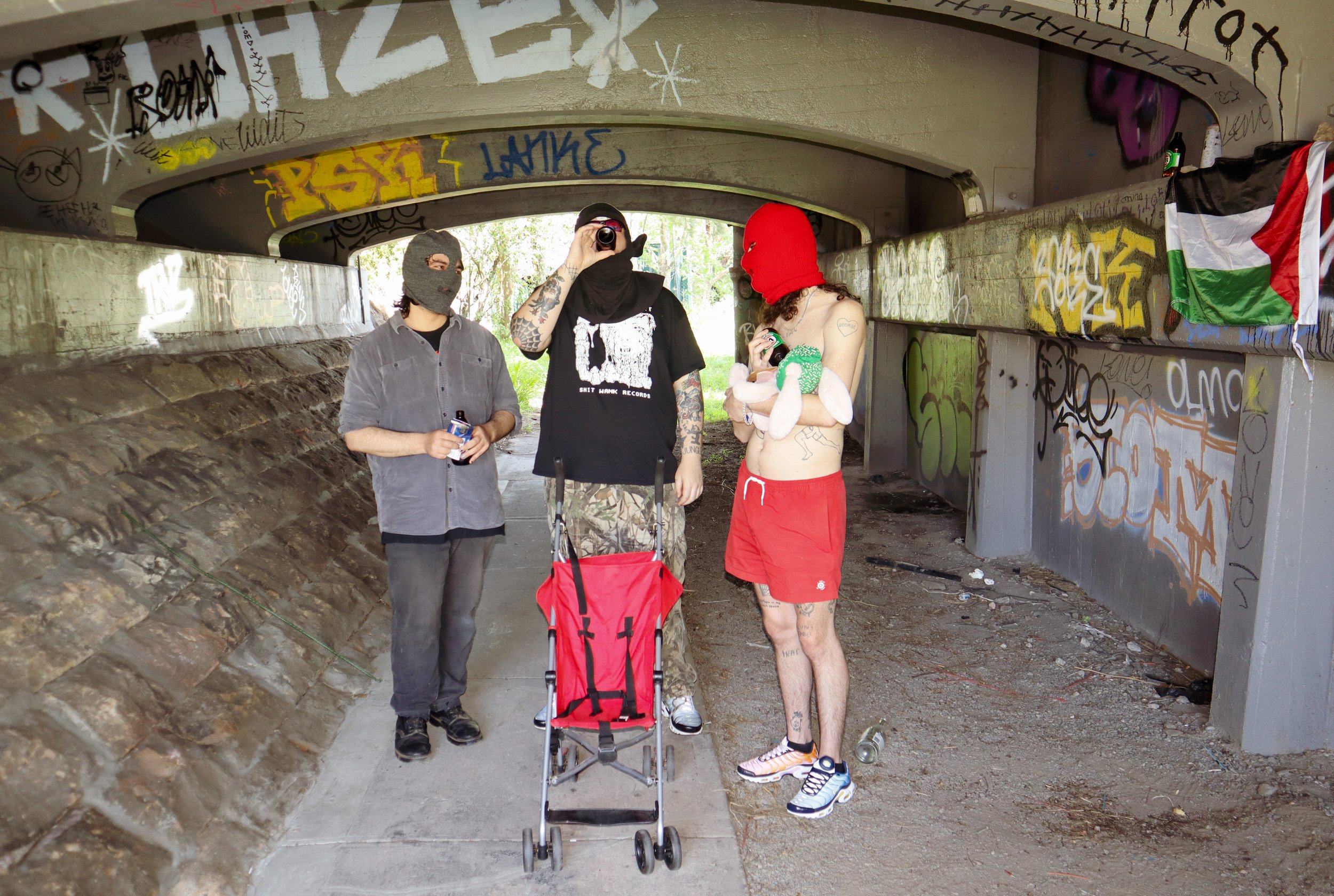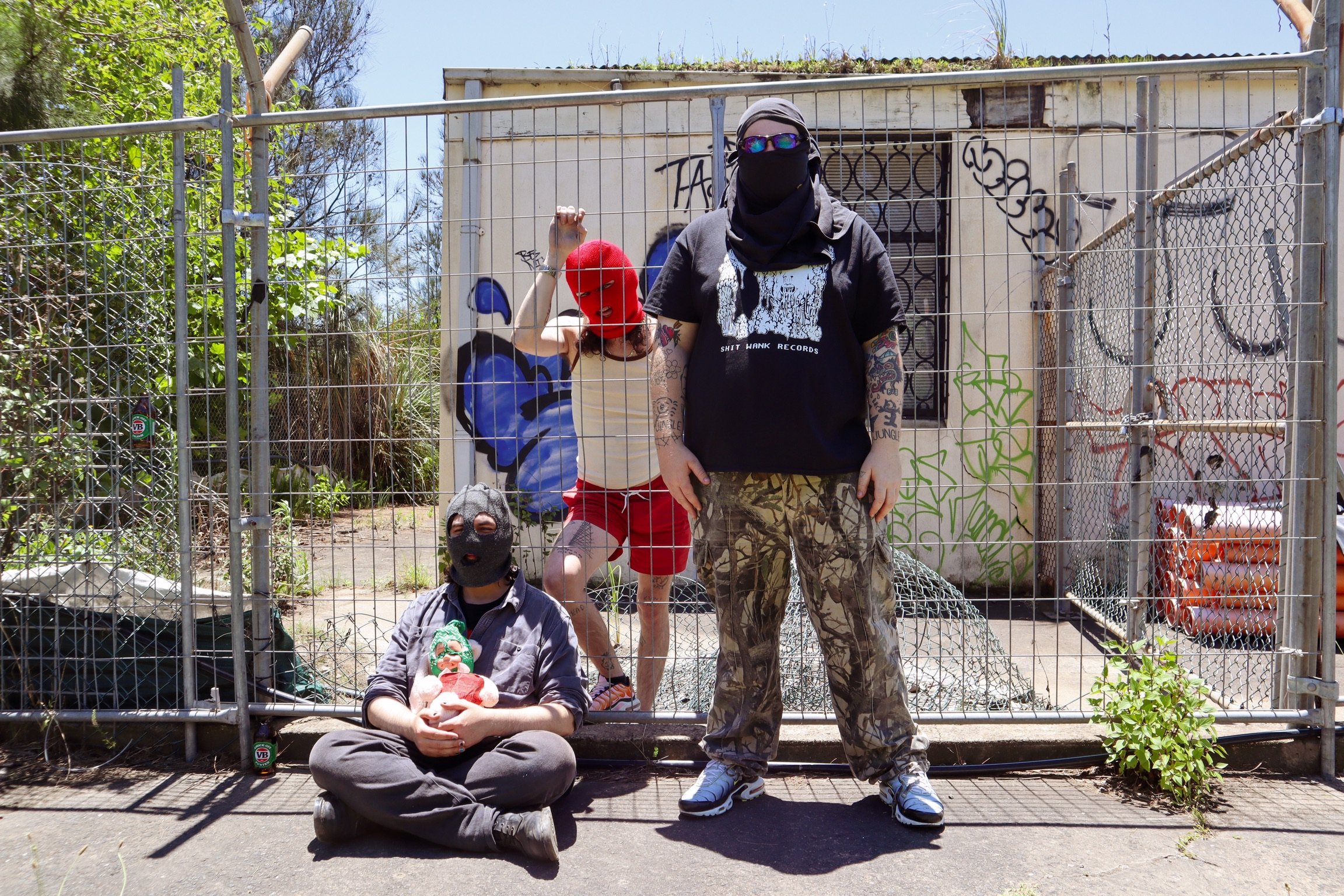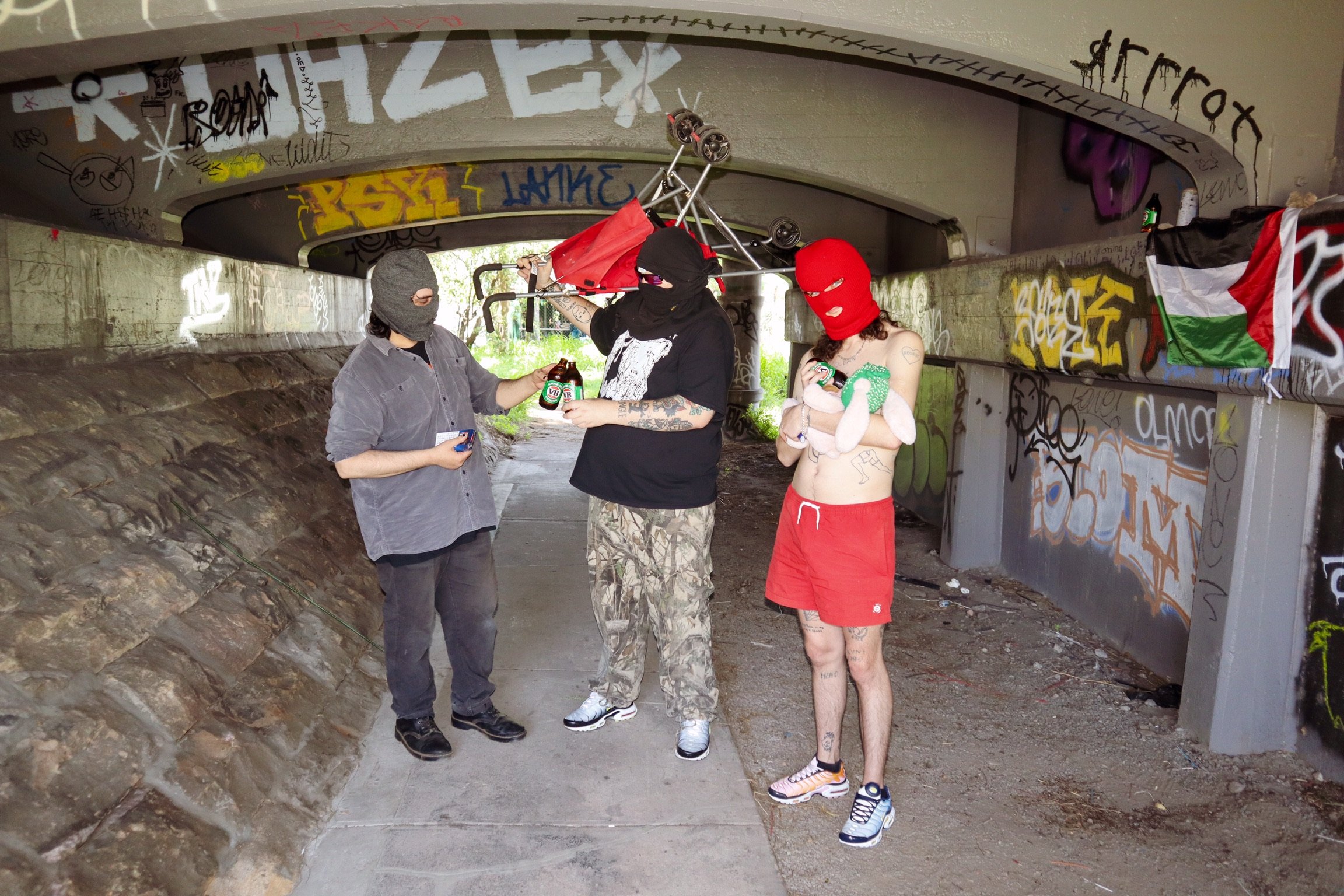200+, Australian breakcore and the musical renaissance nobody asked for
11 PM, 30 September, 2023.
Frenetic bass rhythms emanate from underneath the bridge. Spectral figures appear in the distance as you approach – black dots that bop, trip, gyrate and hakk. Nobody dances pretty here.
Your step quickens.
When you reach the motorway underpass, you find decks and a mixer on a fold-out table, a few rubbish bags scattered around and a handful of static lights. There’s fuck all else in terms of décor. No stage for the DJ. No strobes. No hanging art installations. No camera flashes.
The bloke DJing looks your dad’s age.
As you try to acclimatise – nobody ever fully acclimatises to breakcore – a barrage of hard dance music swallows the 200-strong horde. Harsh noise charges from the rig. Hardcore kicks and amen breaks thump like the drums of a marching band for this ragtag bunch of decibel-addled freaks. Vape smoke billows in opaque sheets like a line of pirate-doof flags flying amid a maelstrom of sound waves. Heads loll on shoulders. Hands exchange cigs and keys.
You hear the unmistakable distortion of somebody shoving their Youtube-to-MP3-converter-rip through a pair of battered PA speakers and an 18 inch sub as they mix twisted breaks into a 00s pop banger with a 180 BPM hardcore kick slapped on top of it.
Even a hardened raver might wonder what the deal is with this ratchet home-job party. But here, within a Middle Earth sized park in Western Sydney, deep in suburbia, you find a big crowd of people who are actually dancing. They’re not sinking into the folds of a couch, trading bumps of ket, or gossiping over a glass of red on the dancefloor; they’re dancing. What’s more, you’re well outside the assumed zone of cultural innovation in Sydney – the Inner West.
Welcome to Blue Heelers: The Bottle-o Run, a free renegade party of borrowed equipment. Sixteen hours of sometimes horrendous, sometimes magical, brain-demolishing beats otherwise known as breakcore. This ongoing event series, run by the record label 200+, has made quite a stir; Victoria Police even sent out a chopper to shut down their first outdoor rave in Melbourne. But it’s hardly music for the masses.
So what the fuck is breakcore and why are people suddenly paying attention to it?
Breakcore is an unwieldy umbrella term for a loose conglomeration of fast-paced music genres with antifascist origins that centre on the principle of breaking as many rules as possible. If we’re to triangulate breakcore sonically, we can locate its ever-changing form bouncing between the poles of hardcore techno, drum’n’bass and IDM. Trace the pathways breakcore creates between diverse genres with whatever-software-whizz-computer-program-this-metaphor-needs and you’ll discover they spell a secret message. But don’t expect anything too cutesy. Breakcore personified is more likely to scream “this music stinks”, “fuck cops” or “slicing up ya prick” (it’s a track by breakcore royalty Passenger of Shit, ok) than “PLUR” – peace, love, unity, respect – although there is a hell of a lot of affection and openness in this community. The artists, event organisers and punters are just a little more preoccupied with flashing their cat ears at fascist dogs and giving a middle-finger salute to normies and commercial music cultures.
Think of breakcore as the punk or metal of the dance music cosmos.
Reflecting on the origins of breakcore, Sean, a Sydney-based breakcore producer aka Melt Unit, explains, “the [punk] ideology didn’t change, the instruments did. You had your crusties sure, but you also had your new-wavers and goths. It was fuck society, all the time. Fuck dress codes. Fuck gender roles. Fuck genre limitations.”
This sample-heavy music, birthed on the internet, is all about chopping up old hip hop records, pop anthems and internet memes, speeding them up and rearranging them into a disjointed turbo-charged sound collage of unashamedly cuckoo beats. Slap some distortion and amen breaks over it all and voila you have your first breakcore album. It’s not exactly high art.
* * *
If tuned into the radio during the COVID-19 pandemic, you may have noticed subtle changes in your listening experience – an increased heart rate, for example, or the invisible hand tugging at your arm, pushing you towards your bedroom dancefloor, tempting you. According to one BBC report, pop music in 2020 contained the highest BPM rate since 2009. As hyperpop has proliferated, contemporary music has moulded itself around the financial imperative of attracting and sustaining listener attention on social media and streaming platforms like Spotify. Tracks have shortened and quickened amid this remix race to the bottom, dance music included. Choruses arrive earlier to satiate our ever-shortening concentration spans. Hyperpop = hek-tek Tik Tok/ringtone music 4 queers & Gen Zs. Speed, speed, MORE SPEED…
Simultaneously, as Y2K euphoria grips social media, a range of faster meaner styles of dance music have re-entered the global nightlife circuit – gabber, donk and drum’n’bass, for instance. Breakcore itself is also having a (very rare) moment in the limelight thanks to Sewerslvt, Goreshit and Machine Girl. Sounds and subcultures once denigrated are now symbols of popular rebellion. As Time announced last year, we are now in an “era of unapologetic bad taste”.
Echoing the view of current music critics, Merrick, one of the five founders of 200+, points out that “breaks are just part of the Spotify and Tik Tok algorithm at the moment”.
Chloe, aka i-DENT, a Sydney-based breakcore producer, suggests zoomers are fiending music that is “a lot harsher and a lot heavier”.
If there is a soundtrack to late stage capitalism, web 2.0 and generation-wide ADHD, it’s the formula alchemy and tempo fuckery of breakcore. Reflecting the non-linear consumption of music and narratives in an internet era of information overload, it aligns with our ravaged attention spans. There’s a cultural resonance to this end-of-history shriek of existential angst, which goes some way towards explaining its current popularity.
But this doesn’t tell the full story either. The breakcore renaissance isn’t necessarily a global story.
There’s confusion, even disbelief, among the 200+ crew that a style of music as unhinged as breakcore is popping off locally.
“We’re all grasping at straws here,” Morgan quips, another 200+ founder.
Music fans today are more fickle than ever. Streaming platforms have fostered a listening public with little patience and an urgent need to be entertained as quickly as possible. Short sensational content – clickbait Buzzfeed listicles, 30 second Instagram reels and Twitter flame wars – dominate digital media. We’re trapped in a spiral of pleasure-seeking, forever chasing the latest dopamine hit.
For breakcore, it’s a double-edged sword. The genre soup you’ll taste at any breakcore event is mouth-watering to zoomers, but the cynics suspect that this cohort of breakcore fans will just as quickly desert the scene once the fad is over.
“I reckon out of this crowd five to ten percent will become dedicated heads and proper cunts who will be all about it for a long period of time. I think the size of these parties will shrink over time,” George from 200+ says.
* * *
Across the last thirty years, droves of Sydney-based creatives have established informal communal living spaces, unlicensed venues, sesh dens and artist studios in the factories and warehouses left vacant by a process of inner city deindustrialisation. Liminal spaces within liminal suburbs – Chippendale, Alexandria, St Peters, Marrickville, Sydenham. With little consideration for licencing laws, sound limits and OH&S, lease-holders, residents and event organisers have thrown raves and band nights regularly within these urban ruins.
If you’ve been around the traps, running amock within Sydney’s underground party scene recently, however, you’ve probably noticed some worrying trends.
First off, there’s no shortage of muscle-tensing authoritarianism in New South Wales. In recent years, sky-rocketing policing fees for festivals, invasive strip searching and chronic underfunding have ravaged Sydney’s arts and hospitality industries. Police raids, local council pressure and sky-rocketing rent have taken their toll, pushing some illegal venue operators to pursue licensing and legitimacy. Others have turned their backs on the scene completely.
Throw COVID-19 in the mix and suddenly corrosive acid was burning skin through the hole-ridden hazmat suit presented to young night owls by NSW Police and the state government. Almost overnight, 2Flies, an iconic warehouse space in Marrickville, folded as tenants, deprived of their main source of income, moved on.
Today, there is a dwindling number of illegal venues left where you can find renegade events and ticket prices for these gigs have steadily increased. For a 6 hour duration event with an international artist and high production value, you’re looking at $40, $50 or $60 for a ticket, even $70 sometimes. As the price of entry has surged and public acceptance of dance music has improved, digestible non-confronting music – tech-house and disco, for example – has increasingly entered the warehouse. It’s hardly the soundtrack of protest.
DIY open-air parties in secluded areas of bush, still within Sydney’s urban labyrinth, and squat raves in abandoned buildings – the kind where the organisers roll up with bolt cutters and a generator – are an appealing alternative to the warehouse. But here too kids scurry blindly in the darkness cast by commercialisation’s shadow. Some crews, often younger and less versed in the politics of illegal partying, have begun to charge as much as $30 or $40 for borderless events with no physical door or security. There are even cases of crews placing their own padlocks on gates to reserve public spaces.
Noneless, a non-binary breakcore producer from Sydney who runs the Trigger Happy rave series, believes a distinctive change occurred during the COVID-19 pandemic. They assert that the true essence of raving – radical self-expression and uninhibited dancing – is rapidly disappearing in Sydney, as slower, almost ambient, electronic music has taken Sydney’s underground by storm, sounds “far from cutting edge”, they complain.
“Warehouse spaces are businesses and they need to be treated and viewed as such,” they contend.
“They are capitalising off the vibe and atmosphere and feeling of not being in a licenced venue and the exhilaration that brings. They’re actually commodifying that culture. In a way, that goes against the entire point of it.”
Over Zoom, the 200+ crew express their distaste for rave organisers that monopolise on the desperation of Sydney punters. They suggest that exorbitant ticket prices limit crowd diversity.
“Charging people to go to a public space to listen to music on a half-assed fucking sound system ain’t on.” Morgan says. “That’s cooked.”
“We also don’t want to charge cunts 40 bucks to go to a 6 hour warehouse party in some wanky, not-even-collectively-owned space,” George adds.
What quickly becomes clear from the interviews I conducted for this story is this: Australia’s breakcore renaissance is more a reaction to the gentrification of the arts and the commercialisation of underground rave scenes than a riposte to the country’s sanitised licensed nightlife.
There’s a grim reality that some in the breakcore community highlight: this post-lockdown era of unlicensed Sydney nightlife is more cottagecore than eschore. 2Flies, although itself an expensive place to host events, had bathrooms with AWOL toilet seats and cubicle doors falling off hinges, seemingly pulled towards the piss-covered floor by the sheer weight of graffiti smothering them. Toothbrushes lined grime-smeared sinks beside empty saddies and nang canisters. Enter these new illegal venues and you’re more likely to find stain-free black leather couches, sleek modern bathrooms, pot plants and vines. To the sceptics, they’re becoming spawn points for TikTok ravers, pursed-lip techno girlies and shirtless tech-bros with glistening bodies devoid of tattoos; they’re threatening to become playgrounds for the city’s artistic elite, the offspring of bankers and lawyers who feign as true-blue battlers on Struggle Street.
In October this year, one techno crew running events out of an Inner West warehouse posted a solemn infographic with a public service announcement. Reading the opening tiles, you’d think someone had stolen their Funktion-One soundsystem or there was a drug overdose at one of their events.
But no. Someone had simply thrown up a couple of tags inside their hallowed venue, God forbid. The response? A public scolding and a declaration of intention to close their venue for weeks and thereafter search the bags of all punters and confiscate any displeasing paraphernalia. In reacting so severely, the crew publicly admitted to a desire to replicate the cop mentality and invasions of privacy so prevalent within the city’s sanitised nightclubs. It exposed the true feelings of some deeply-embedded individuals in Sydney’s DIY rave scene, as did the charming comments section, which was rife with classism and condemnation of eshay culture.
Chloe suggests that Gen Zs have flocked to breakcore because they’re craving a genuine alternative to mainstream club culture and “the oversaturation of techno and d’n’b parties”. Amid this cost-of-living crisis, the breakcore community with its dedication to free party culture offers a high-octane refuge for young Sydneysiders. It’s a ramshackle commune where anarchy rules but it’s hard to say no to the lack of barriers to entry, the backyard-bouncing-castle energy and the full-scale LARPing and furry operations that organically sprout from the cigarette ashes and dust that billow under motorway underpasses come Saturday night.
Whether they like breakcore or not – it’s certainly an acquired taste – Chloe stresses that Gen Zs are turning up in droves to breakcore raves precisely because they’re free.
* * *
As a neurodivergent breakcore producer/DJ, Chloe quickly became disillusioned attending raves in Sydney. It was 2020 and they’d recently finished high school and moved from the Blue Mountains to the Big Smoke.
“I would sit in the back corner while everyone was smoking cigarettes and acting cool. You only went behind the DJ booth if you were cool. I just never felt cool… I remember hearing about psy trance doofs and people finding their tribe. There was so much talk of community but I didn’t feel it. It’s nothing personal; I just don’t think I was ever meant to belong in those circles.”
In the Blue Mountains one night, however, in front of all of 20 people, Chloe discovered what they had been yearning for years: a community. It was a breakcore party, and only the second show she’d ever played.
“Swift [Passenger of Shit] hired out this dance hall”, Chloe explains. “It was literally me, my friends, my mum and dad and sister, all the 200 Plus crew. My USB fucked up. I did a back-to-back with Morgan. Morgan said: ‘does your mum like ABBA?’ My mum’s sitting there at the back like ‘hi Chloe!’ He blasted the most fucking speedcore ABBA mix. It was so indigestible and my mum was standing there smiling through it all.”
“That’s when I realised breakcore is my home away from home.”
“I could unmask myself around these people. I could just be myself and talk about the most niche, fringe, dumb, chronically online shit and they understood and got it and welcomed me with open arms.”
Nobody knows how many people are neurodivergent in Australia’s breakcore community. There are no ethnographic researchers bringing notepads and pens to breakcore raves and no sociologists collating data on the scene. I imagine a social scientist would meet trolling at best and silence at worst if they tried to write about this subculture. But, if I’m to hazard a guess, I’d say 90 percent of the punters at breakcore parties are on some kind of spectrum. It’s the groups of people howling at patterns on the ground in unison and wizard hat fashion that gives it away.
As George from 200+ eloquently explains, breakcore represents “the trifecta of ADHD, autism and stimulant abuse”.
It’s not just the music that appeals to those with a few screws lose, 200+ consciously build physical environments catered to neurodivergence. Minimal static lighting at their raves is one example. “No strobes, no flashy bullshit, just fast tempos”, read the promo for their first event, Gurning Man ‘The Prequel’.
Morgan says, “we get a lot of people messaging us or saying thanks at raves for not using strobes. A lot of people with sensory issues and epilepsy come to our parties. For a lot of them it’s their first rave because they’ve been worried about the lighting at more traditional raves.”
As techno and trance has lost its revolutionary sheen, the harder end of the dance music spectrum has become a haven for the outcasts – the kandi ravers, weebos, cybergoths, trans folks, middle-aged punks, neurodivergent psychonauts and furries sidelined by the normalisation of dance music. In the shadow of Sydney’s over-policed mainstream hardcore community – a traditionally male-dominated arena – a queer experimental hardcore scene, which preceded hyperpop by at least fifteen years, has flourished, undetected. Just google Neko Nation. Wedged between gym-bro hardstyle and festival drum’n’bass, it’s probably not where you’d expect to find the liberatory potential and camaraderie of the rave utopia. But this is a community where goofiness is encouraged and gender stereotypes mutate.
In the place of frowning punters and uniformity in dress, staples at techno and arena-filling hardcore festivals, there’s theatre. Prepare to get freaky, performers warn, in roundabout ways. In the early 00s, members of the now-defunct Sydney breakcore label System Corrupt incorporated subversive, homoerotic collages into their rave flyers and visuals at events to drive away the staunchly hetero crowd of mainstream hardcore. This is subversive performance as a safeguard in a scene where anything goes, where you might be showered in piss one moment – it happened to Sean at a Butchers Harem set at the Hamilton Station Hotel in Newcastle – and subjected, the next moment, to Toecutter murdering and distorting the living hell out of Cold Chisel in his underwear.
Recounting his favourite breakcore memories, Sean refers to a friend, alias 7U, who turned up to the International Noise Conference at Dirty Shirlows in 2011 with a new conceptual act – BA Lert.
“Trying to sync multiple circuit bent car alarms was a hilarious exercise in futility, and noise pollution,” Sean explains.
* * *
It’s a Sunday morning in December and I’m shovelling debris under a bridge on the outskirts of Sydney’s Inner West with Adriana, No Filter’s fashion and photoshoot guru. Three of the NSW-based founders of 200+ – George, Ian and Morgan – are already discovering the bottoms of their VB stubbies. Loitering is hard work.
(We don’t have the funding to fly Merrick, another 200+ founder, up from Melbourne for this shoot sadly. As much as we’d love to send out a helicopter during this national tragedy in the vein of Lucy Dudko – that Australian woman who broke her crim boyfriend out of Silverwater Prison in 1999 with a hijacked chopper – we don’t fancy our chances of breaking Merrick out of Australia’s biggest shithole, Melbourne.)
George jokes at one point that they were going to tell us to meet for the photoshoot at a cool room, and then arrive one hour later to rescue us, which just about sums up breakcore. It’s a music genre people love to hate – a judgement welcomed and ridiculed by the community.
As Sean (Melt Unit) explains, “breakcore was the original troll music genre, before the word trolling was invented.”
This tongue-in-cheek humour has probably resonated deeper in Australia than anywhere else. It’s a thematic thread you can draw between the country’s early pioneering breakcore labels – Bloody Fist Records, System Corrupt, Shit Wank Records and Night Terror Recordings – and the current crop.
Reflecting on the heady frontier years of Australian breakcore, Sean explains, “the second a trend would emerge, the Aussies would deliberately mock it, take the absolute piss out of it. Never take yourself too seriously, never stick your tall poppy head up too far up your own arse.”
Aside from the brief flash in the pan that was Melbourne bounce, Australians can’t lay claim to pioneering many music genres. It’s not coincidental that breakcore is one of the few exceptions. But it’s a little-known history.
From the mid 90s, New South Wales was home to an abrasive, globally-respected network of hardcore techno producers with a cult following. In Newcastle, Australia, Mark Newlands, aka DJ Mark N, founded the label Bloody Fist Records with his dole payments. Cornered by smoke stacks, barbed wire, steelworks operations and concrete, the label became a production line of its own for a pinball machine of eclectic hardcore beats and chopped up hip hop samples. Thus the world was blessed (doomed?) with albums such as Straight Out Of Newcastle – the “middle class white” version of NWA’s Straight Outta Compton, as Mark once told an ABC reporter. With high PPM (profanities per minute), these early breakcore tracks pin you down and forcefully inject angst with a steamrolling dose of tall-poppy syndrome – all while telling you to lighten up.
Trawl through Discogs, Ebay and Facebook today and you’ll find Bloody Fist vinyls selling for hundreds of dollars. For a style of music nicknamed “cheapcore”… If that’s not proof of cult status, I don’t know what is.
Traces of this DIY, cut and paste mentality can be found in the production of later Australian breakcore artists, such as Passenger of Shit, Toecutter and Melt Unit. What emerged was a group of producers and DJs unafraid to mock the nation’s cultural cringe. It was a satirical take on Australiana, Sean explains, “a love-hate relationship of kitsch schlock”.
In the music they platform – more jarring and distorted than the ethereal melodies and fast breaks of new breakcore artists like Sewerslvt – the 200+ crew are a throwback to the Australian breakcore of old. It bleeds through in their events and their individual personalities as well. This is the New Age Larrakin.
But it’s not all silliness and trolling. There’s heart underneath the bravado, and political awareness. For their last gig at the Burdekin Hotel in Sydney, 200+ donated all profits to the Asylum Seekers Centre.
“Breakcore is like the communism of the music scene. No one’s trying to sell anyone something,” Morgan tells me excitedly over Instagram when I first pitch the story to the crew.
Underneath George’s joke about a cool room adventure, I sense a hint of discomfort that someone is writing about breakcore. Within the broader breakcore community, there’s an apprehension that media coverage and renewed popularity may result in undesired elements entering the scene and misunderstanding its politics. Both Chloe and Noneless touch on this concern. When it comes to the 200+ crew though, I think they’re simply not interested in appearing cool, garnering attention or coming across as serious. In fact, they don’t seem like they’re trying to be anything, except chaotic. The theme for this shoot, George tells us, is “dysfunctional family”.
This is a community content to remain underground. Contrary to the modern incarnation of dance music, which involves the passive consumption of a rave-spectacle, superstar DJs performing in packed-out arenas and Spotify/Instagram analytics directing careers, breakcore artists actively eschew fame. As a journalist, I feel like I am skirting the edges of hallowed turf, trespassing. It’s like someone has nailed a “Keep Out” sign to their front door and padlocked the chain-link gate around their property. I stand there camera in hand, a bazooka-sized long-focus lens perched between the gaps in the chain fence. But I’m granted entry to the property in the end by virtue of being a known face and a fan.
I don’t blame them. From performers circuit bending car alarms for half an hour to free renegade raves with a fold-out table, breakcore has a fair claim to be the only remaining, genuinely countercultural, dance music scene in Australia. You won’t hear anyone in the breakcore community parroting this claim but I’ll stake the claim.
It’s the exact reason this online genre is transcending the boundaries of cyberspace more than ever before, the reason this isolated community has become a rallying point for gut-punching sound terrorism.
You can forgive them for being a little bit wary.

